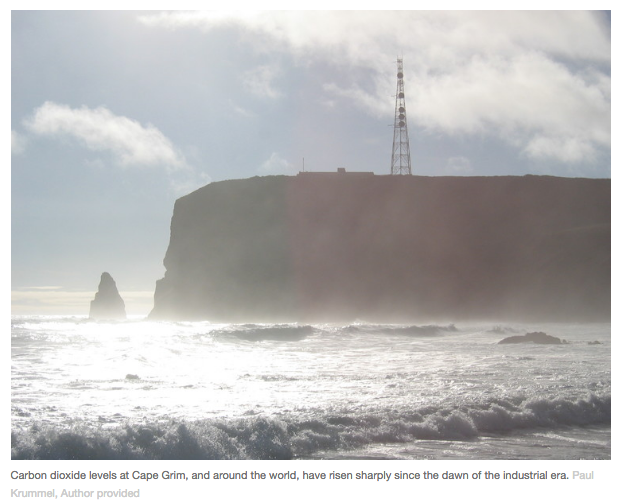Can you cut 1 Tonne of carbon pollution out of your life?
Take the challengeAtmospheric carbon dioxide measurements at Tasmania's Cape Grim and Antarctica's Casy Station have now officially passed 400 parts per million and are likely to stay above that for decades to come.
Written by
The background atmospheric carbon dioxide levels measured at Cape Grim on Tasmania's northwest coast have officially passed the 400 parts per million (ppm) mark. Our measurements, compiled by our team at CSIRO together with the Bureau of Meteorology, show that the milestone was reached on May 10.
In the past few days, the 400 ppm level has also been breached in Antarctica, where CSIRO's measurements at Casey Station show the 400 ppm level was exceeded on May 14.
Together, these measurements show that the atmospheric CO₂ concentration of the entire southern hemisphere is now at or above 400 ppm. It is unlikely to dip back below this level for many decades to come.

The threshold was reached earlier than we and our colleagues had anticipated, as a result of a recent, strong increase in the growth rate of atmospheric CO₂. This was probably driven by increased emissions from fossil fuels, as well the impact of the recent strong El Niño, which reduced the capacity of natural systems such as oceans and plants to absorb CO₂.
Southern hemisphere lag
CO₂ concentrations over the southern hemisphere are trailing those in the planet's northern half, where 400 ppm level was breached in 2014-15. The northern hemisphere's carbon dioxide levels are higher because most CO₂ sources (such as vegetation and fossil-fuel-burning installations) are mainly found in the north, whereas CO₂ "sinks" such as oceans are predominantly in the southern hemisphere.
The northern hemisphere's CO₂ levels also show a much stronger seasonal variation. Ironically, the only place on Earth where baseline levels of CO₂ are likely to stay under 400 ppm for the next few years is the high Arctic, where the extreme summer carbon dioxide minimum will likely result in sub-400 ppm averages for 2017 and 2018.
After that, however, the world's background levels of CO₂ are unlikely to fall back below 400 ppm for many decades – perhaps a century or more – depending on the success of humankind's efforts to reduce emissions.

What does 400 ppm really mean?
The 400 ppm level of atmospheric CO₂ is largely symbolic. The real concern is the current rate at which this figure is increasing: roughly 3 ppm per year. If this were to continue for another two decades, we would pass 450 ppm of CO₂. Once that level is reached, the levels of all greenhouse gases put together (carbon dioxide, methane, nitrous oxide and synthetic greenhouse gases) would add up to the equivalent of about 550 ppm of CO₂.
This is the level at which average global temperatures would be likely to reach 2℃ above pre-industrial levels in the decades thereafter (given the time lag between atmospheric CO₂ and its global warming impact).
This is the amount of global warming that the Paris Agreement is designed to avoid – indeed, the agreement calls for temperatures to be held well below this level.
It is clear that strong, worldwide initiatives aimed at curbing carbon dioxide emissions are needed now if we are to avoid the most dangerous predicted effects of climate change.
A relentless trend
Atmospheric CO₂ has been increasing relentlessly over the past 200 years or so, as can be seen in the chart below. Air and ice measurements allow us to trace the dramatic rise in CO₂ levels from about 280 ppm, before the start of the industrial era around the year 1800, to the current level above 400 ppm.

That is an increase of 43% in scarcely more than two centuries, largely as a result of human activities. The time to start reversing that trend is now.
Read this next: Direct action doesn't give us a bang for our buck when it comes to climate change
Banner image: Unsplash
